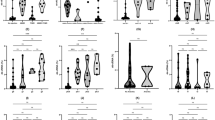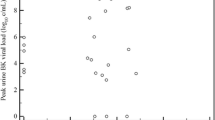Abstract
BK polyomavirus-associated nephropathy (BKPyVAN) is a common cause of allograft failure. However, differentiation between BKPyVAN and type I T cell-mediated rejection (TCMR) is challenging when simian virus 40 (SV40) staining is negative, because of the similarities in histopathology. This study investigated whether donor-derived cell-free DNA (ddcfDNA) can be used to differentiate BKPyVAN. Target region capture sequencing was applied to detect the ddcfDNAs of 12 recipients with stable graft function 22 with type I TCMR, 21 with proven BKPyVAN and 5 with possible PyVAN. We found that urinary ddcfDNA levels were upregulated in recipients with graft injury whereas plasma ddcfDNA levels were comparable for all groups. The median urinary concentrations and fractions of ddcfDNA in proven BKPyVAN recipients were significantly higher than those in type I TCMR recipients (10.4 vs. 6.1 ng/mL, P<0.001 and 68.4% vs. 55.3%, P=0.013, respectively). Urinary ddcfDNA fractions (not concentrations) were higher in the BKPyVAN-pure subgroup than in the BKPyVAN-rejection-like subgroup (81.30% vs. 56.64%, P=0.025). With a cut-off value of 7.81 ng/mL, urinary ddcfDNA concentrations distinguished proven BKPyVAN from type I TCMR (area under the curve (AUC)=0.848, 95% confidence interval (95% CI): 0.734 to 0.963). These findings suggest that urinary ddcfDNA is a non-invasive biomarker which can reliably differentiate BKPyVAN from type I TCMR.
摘要
目的
BK病毒相关肾病(BKPyVAN)是移植肾丢失的常见原因之一。然而, 由于BKPyVAN和I型T细胞介导的排斥反应(TCMR)具有相似的病理表现, 因此在猿猴空泡病毒40(SV40)染色阴性时, 病理鉴别两者具有难度.
创新点
本文首次研究了供体来源的细胞游离DNA(ddcfDNA)能否区分BKPyVAN和I型TCMR.
方法
采用目标区域杂交捕获测序检测法, 对12例肾功能稳定、22例I型TCMR、21例病理证实BKPyVAN和5例疑似PyVAN患者的ddcfDNA进行检测.
结论
在有移植物损伤时, 患者尿液中ddcfDNA水平增加, 而血浆中ddcfDNA无明显改变。病理证实BKPyVAN组尿液ddcfDNA的浓度和百分比的中位数均明显高于I型TCMR组(10.4 vs. 6.1 ng/mL, P<0.001;68.4% vs. 55.3%, P=0.013)。在单纯BKPyVAN亚组中, 尿液ddcfDNA的百分比较BKPyVAN排斥样改变组升高明显(81.30% vs. 56.64%, P=0.025), 而ddcfDNA的浓度则无明显升高。尿液ddcfDNA浓度7.81 ng/mL可作为区分病理证实BKPyVAN和I型TCMR的阈值(AUC=0.848, 95%置信区间:0.734–0.963).
Similar content being viewed by others
References
Agbor-Enoh S, Tunc I, de Vlaminck I, et al., 2017. Applying rigor and reproducibility standards to assay donor-derived cell-free DNA as a non-invasive method for detection of acute rejection and graft injury after heart transplantation. J Heart Lung Transplantat, 36(9):1004–1012. https://doi.org/10.1016/j.healun.2017.05.026
Agrawal N, Echenique IA, Meehan SM, et al., 2017. Variability in assessing for BK viremia: whole blood is not reliable and plasma is not above reproach—a retrospective analysis. Transpl Int, 30(7):670–678. https://doi.org/10.1111/tri.12951
Ahuja M, Cohen EP, Dayer AM, et al., 2001. Polyoma virus infection after renal transplantation: use of immunostaining as a guide to diagnosis. Transplantation, 71(7):896–899. https://doi.org/10.1097/00007890-200104150-00013
Bloom RD, 2019. Using (cell-free) DNA to incriminate rejection as the cause of kidney allograft dysfunction: do we have a verdict? Am J Transplant, 19(6):1609–1610. https://doi.org/10.1111/ajt.15338
Bloom RD, Bromberg JS, Poggio ED, et al., 2017. Cell-free DNA and active rejection in kidney allografts. J Am Soc Nephrol, 28(7):2221–2232. https://doi.org/10.1681/ASN.2016091034
Blydt-Hansen TD, Gibson IW, Gao A, et al., 2015. Elevated urinary CXCL10-to-creatinine ratio is associated with subclinical and clinical rejection in pediatric renal transplantation. Transplantation, 99(4):797–804. https://doi.org/10.1097/tp.0000000000000419
Buettner M, Xu H, Böhme R, et al., 2012. Predominance of TH2 cells and plasma cells in polyoma virus nephropathy: a role for humoral immunity. Hum Pathol, 43(9): 1453–1462. https://doi.org/10.1016/j.humpath.2011.11.006
Chen XT, Wang ZY, Huang Y, et al., 2019. Combined detection of urine specific gravity and BK viruria on prediction of BK polyomavirus nephropathy in kidney transplant recipients. Chin Med J, 133(1):33–40. https://doi.org/10.1097/cm9.0000000000000579
Chen XT, Chen WF, Li J, et al., 2020. Urine donor-derived cellfree DNA helps discriminate BK polyomavirus-associated nephropathy in kidney transplant recipients with BK polyomavirus infection. Front Immunol, 11:1763. https://doi.org/10.3389/fimmu.2020.01763
Christakoudi S, Runglall M, Mobillo P, et al., 2019. Development of a multivariable gene-expression signature targeting T-cell-mediated rejection in peripheral blood of kidney transplant recipients validated in cross-sectional and longitudinal samples. EBioMedicine, 41:571–583. https://doi.org/10.1016/j.ebiom.2019.01.060
de Vlaminck I, Martin L, Kertesz M, et al., 2015. Noninvasive monitoring of infection and rejection after lung transplantation. Proc Natl Acad Sci USA, 112(43):13336–13341. https://doi.org/10.1073/pnas.1517494112
Dharnidharka VR, Cherikh WS, Abbott KC, 2009. An OPTN analysis of national registry data on treatment of BK virus allograft nephropathy in the United States. Transplantation, 87(7):1019–1026. https://doi.org/10.1097/TP.0b013e31819cc383
Drachenberg CB, Papadimitriou JC, Hirsch HH, et al., 2004. Histological patterns of polyomavirus nephropathy: correlation with graft outcome and viral load. Am J Transplant, 4(12):2082–2092. https://doi.org/10.1046/j.1600-6143.2004.00603.x
Drachenberg CB, Papadimitriou JC, Chaudhry MR, et al., 2017. Histological evolution of BK virus-associated nephropathy: importance of integrating clinical and pathological findings. Am J Transplant, 17(8):2078–2091. https://doi.org/10.1111/ajt.14314
Gielis EM, Ledeganck KJ, Dendooven A, et al., 2019. The use of plasma donor-derived cell-free DNA to monitor acute rejection after kidney transplantation. Nephrol Dial Transplant, 35(4):714–721. https://doi.org/10.1093/ndt/gfz091
Gniewkiewicz MS, Czerwińska M, Gozdowska J, et al., 2019. Urinary levels of CCL2 and CXCL10 chemokines as potential biomarkers of ongoing pathological processes in kidney allograft: an association with BK virus nephropathy. Pol Arch Intern Med 129(9):592–597. https://doi.org/10.20452/pamw.14926
Haas M, Loupy A, Lefaucheur C, et al., 2018. The Banff 2017 Kidney Meeting Report: revised diagnostic criteria for chronic active T cell-mediated rejection antibody-mediated rejection and prospects for integrative endpoints for next-generation clinical trials. Am J Transplant, 18(2): 293–307. https://doi.org/10.1111/ajt.14625
Hirsch HH, Randhawa PS, 2019. BK polyomavirus in solid organ transplantation—Guidelines from the American Society of Transplantation Infectious Diseases Community of Practice. Clin Transplant, 33(9):e13528. https://doi.org/10.1111/ctr.13528
Hirsch HH, Knowles W, Dickenmann M, et al., 2002. Prospective study of polyomavirus type BK replication and nephropathy in renal-transplant recipients. N Engl J Med, 347(7):488–496. https://doi.org/10.1056/NEJMoa020439
Hirsch HH, Brennan DC, Drachenberg CB, et al., 2005. Polyomavirus-associated nephropathy in renal transplantation: interdisciplinary analyses and recommendations. Transplantation 79(10):1277–1286. https://doi.org/10.1097/01.tp.0000156165.83160.09
Huang E, Sethi S, Peng A, et al., 2019. Early clinical experience using donor-derived cell-free DNA to detect rejection in kidney transplant recipients. Am J Transplant, 19(6): 1663–1670. https://doi.org/10.1111/ajt.15289
Kant S, Bromberg J Haas M, et al., 2020. Donor-derived cellfree DNA and the prediction of BK virus-associated nephropathy. Transplant Direct, 6(11):e622. https://doi.org/10.1097/txd.0000000000001061
Knowles WA, Pipkin P, Andrews N, et al., 2003. Population-based study of antibody to the human polyomaviruses BKV and JCV and the simian polyomavirus SV40. J Med Virol, 71(1):115–123. https://doi.org/10.1002/jmv.10450
Mannon RB, Hoffmann SC, Kampen RL, et al., 2005. Molecular evaluation of BK polyomavirus nephropathy. Am J Transplant, 5(12):2883–2893. https://doi.org/10.1111/j.1600-6143.2005.01096.x
Pang XL, Doucette K, LeBlanc B et al., 2007. Monitoring of polyomavirus BK virus viruria and viremia in renal allograft recipients by use of a quantitative real-time PCR assay: one-year prospective study. J Clin Microbiol, 45(11): 3568–3573. https://doi.org/10.1128/JCM.00655-07
Romagnani P, Crescioli C, 2012. CXCL10: a candidate bio-marker in transplantation. Clin Chim Acta, 413(17–18): 1364–1373. https://doi.org/10.1016/j.cca.2012.02.009
Schütz E, Fischer A, Beck J, et al., 2017. Graft-derived cellfree DNA a noninvasive early rejection and graft damage marker in liver transplantation: a prospective observational, multicenter cohort study. PLoS Med, 14(4):e1002286. https://doi.org/10.1371/journal.pmed.1002286
Shen J, Guo LY, Yan PP, et al., 2020. Prognostic value of the donor-derived cell-free DNA assay in acute renal rejection therapy: a prospective cohort study. Clin Transplant, 34(10):e14053. https://doi.org/10.1111/ctr.14053
Sigdel TK, Vitalone MJ, Tran TQ, et al., 2013. A rapid noninvasive assay for the detection of renal transplant injury. Transplantation, 96(1):97–101. https://doi.org/10.1097/TP.0b013e318295ee5a
Sigdel TK, Gao YQ, He JT, et al., 2016. Mining the human urine proteome for monitoring renal transplant injury. Kidney Int, 89(6):1244–1252. https://doi.org/10.1016/j.kint.2015.12.049
Weseslindtner L, Hedman L, Wang YL, et al., 2020. Longitudinal assessment of the CXCL10 blood and urine concentration in kidney transplant recipients with BK polyomavirus replication—a retrospective study. Transpl Int, 33(5): 555–566. https://doi.org/10.1111/tri.13584
Yapici @@Ü, Kers J, Slavujevic-Letic I, et al., 2016. Intragraft blood dendritic cell antigen-1-positive myeloid dendritic cells increase during BK polyomavirus-associated nephropathy. J Am Soc Nephrol, 27(8):2502–2510. https://doi.org/10.1681/ASN.2015040442
Zeng G, Huang Y, Huang Y, et al., 2016. Antigen-specificity of T cell infiltrates in biopsies with T cell-mediated rejection and BK polyomavirus viremia: analysis by next generation sequencing. Am J Transplant, 16(11):3131–3138. https://doi.org/10.1111/ajt.13911
Zhou Q, Liu F, Guo LY, et al., 2021. A novel urine cell-free DNA preservation solution and its application in kidney transplantation. Nephrology, 26(8):684–691. https://doi.org/10.1111/nep.13884
Zhou Y, Yang GD, Liu HT, et al., 2019. A noninvasive and donor-independent method simultaneously monitors rejection and infection in patients with organ transplant. Transplant Proc, 51(6):1699–1705. https://doi.org/10.1016/j.transproceed.2019.04.051
Acknowledgments
This study was supported by the Science and Technology Department of Zhejiang Province (No. 2019C03029), the Bethune Charitable Foundation (No. G-X-2019-0101-12), the National Natural Science Foundation of China (Nos. 81870510, 81770719, 81770752, and 81370851), and the Zhejiang Provincial Natural Science Foundation of China (No. LQ18H050002).
Author information
Authors and Affiliations
Corresponding author
Additional information
Author contributions
Jia SHEN and Rending WANG contributed to study design and data interpretation. Luying GUO and Rending WANG contributed to data analysis, data interpretation, and writing. Wenhua LEI, Shuaihui LIU, Pengpeng YAN, Jingyi ZHOU, and Qin ZHOU contributed to data collection. Haitao LIU, Feng LIU, and Tingya JIANG performed data analysis. Huiping WANG, Jianyong WU, and Jianghua CHEN contributed to manuscript-writing advice. All authors have read and approved the final manuscript, and therefore, have full access to all the data in the study and take responsibility for the integrity and security of the data.
Compliance with ethics guidelines
Jia SHEN, Luying GUO, Wenhua LEI, Shuaihui LIU, Pengpeng YAN, Haitao LIU, Jingyi ZHOU, Qin ZHOU, Feng LIU, Tingya JIANG, Huiping WANG, Jianyong WU, Jianghua CHEN, and Rending WANG declare that they have no conflict of interest.
All procedures followed were in accordance with the ethical standards of the responsible committee on human experimentation (institutional and national) and with the Helsinki Declaration of 1975, as revised in 2008 (5). Informed consent was obtained from all patients for being included in the study. Additional informed consent was obtained from all patients for which identifying information is included in this article.
Supplementary information
Figs. S1–S3
Supplementary Material
Rights and permissions
About this article
Cite this article
Shen, J., Guo, L., Lei, W. et al. Urinary donor-derived cell-free DNA as a non-invasive biomarker for BK polyomavirus-associated nephropathy. J. Zhejiang Univ. Sci. B 22, 917–928 (2021). https://doi.org/10.1631/jzus.B2100131
Received:
Accepted:
Published:
Issue Date:
DOI: https://doi.org/10.1631/jzus.B2100131
Key words
- Donor-derived cell-free DNA (ddcfDNA)
- BK polyomavirus-associated nephropathy (BKPyVAN)
- T cell-mediated rejection (TCMR)
- Urine
- Differential diagnosis




